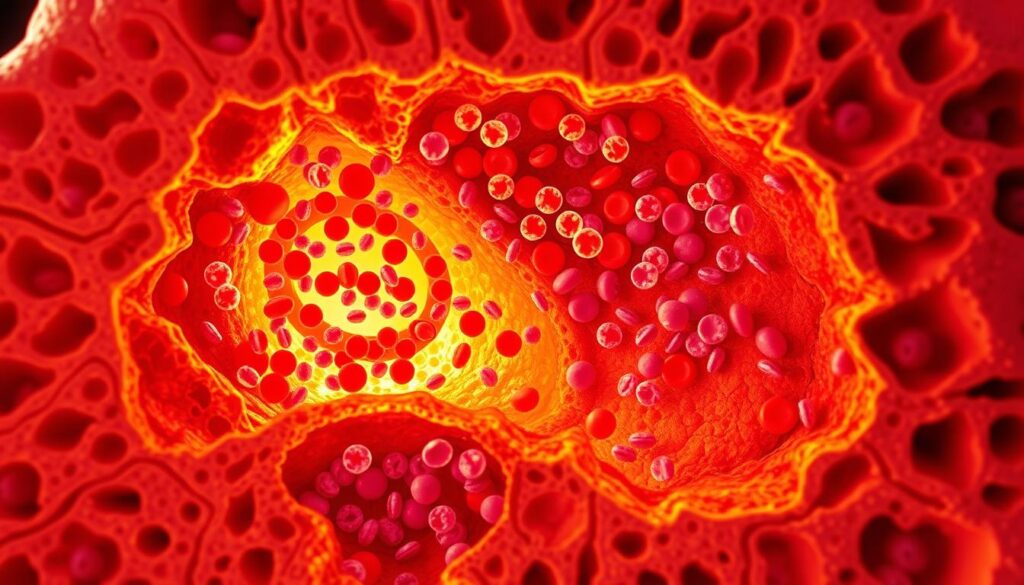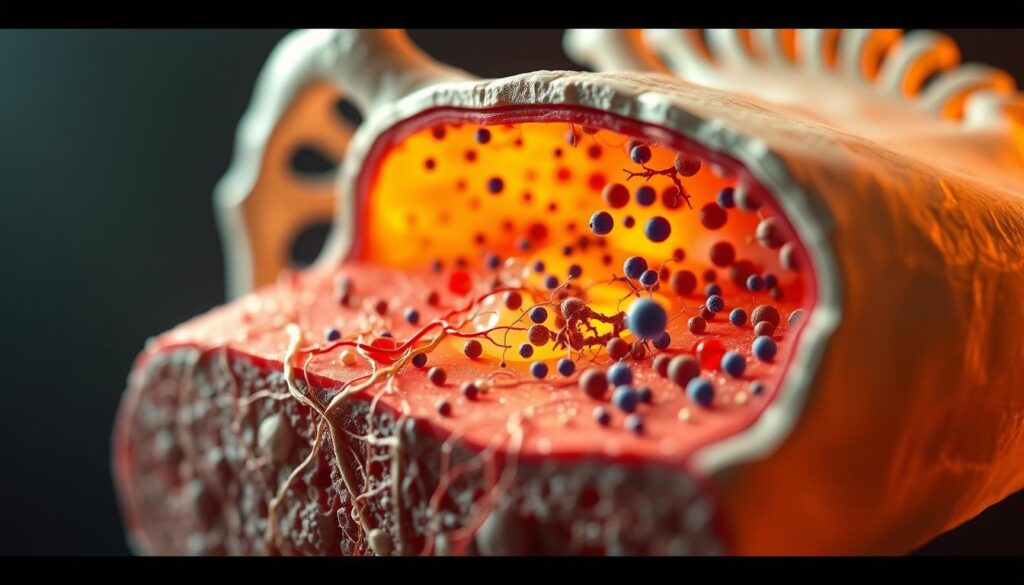Every year, about 18,000 people learn a crucial fact about their health. Their bone marrow could be the key to their survival1. This soft, gelatinous tissue inside your bones is more than just another part of your body. It’s a vital organ that keeps you alive.
Your bone marrow is like a factory inside your bones. It makes billions of blood cells every day. These cells are the backbone of your immune system and your overall health. Without it, your body can’t fight off infections, heal wounds, or keep up with life’s essential processes.
Bone marrow has two types of tissue: red and yellow. The red marrow makes blood cells, while the yellow stores energy. Knowing how this vital organ works can change how you manage your health.
Key Takeaways
- Bone marrow produces billions of blood cells daily
- It plays a crucial role in immune system function
- Red and yellow marrow serve different but essential purposes
- Approximately 18,000 people face bone marrow-related health challenges annually
- Your bone marrow is a critical component of overall inner health
Understanding Bone Marrow: Your Body’s Blood Factory
Your bone marrow is a remarkable biological powerhouse. It functions as a critical blood factory that sustains your entire body’s health. This complex tissue generates billions of essential blood cells daily. It plays a vital role in your immune system and overall well-being2.
The bone marrow structure is incredibly sophisticated. It contains two primary types of stem cells: hematopoietic stem cells and mesenchymal stem cells. These powerful cellular components work together to maintain your body’s blood production and repair mechanisms3.
Cellular Production and Distribution
Your bone marrow generates blood cells through a process called hematopoiesis. This process produces various cell types with different lifespans:
- Neutrophils: Last only hours
- Platelets: Survive for days
- Red blood cells: Persist for months
- Lymphocytes: Can survive for years2
Location and Transformation
The distribution of bone marrow changes dramatically throughout your lifetime. In newborns, all bone marrow is red and actively producing blood cells. By adulthood, red bone marrow concentrates in specific areas:
- Vertebrae
- Hips
- Breastbone
- Ribs
- Skull
- Ends of long bones3
Functional Complexity
Your bone marrow adapts dynamically to your body’s needs. Yellow marrow, which primarily stores fat, can transform back into red marrow during critical conditions like severe blood loss or fever3. This incredible flexibility underscores the bone marrow’s importance as your body’s sophisticated blood factory.
Red vs. Yellow Bone Marrow: The Two Vital Types
Your body has two kinds of bone marrow, each vital for your health. Red and yellow bone marrow change as you grow older4.
Red bone marrow is key in making blood cells, creating about 95% of your blood5. It makes important parts like:
- Red blood cells
- White blood cells
- Platelets
As you get older, your bone marrow changes. Babies have mostly red marrow, while adults have about half red and half yellow5. By adulthood, red marrow mainly stays in bones like the skull and pelvis4.
Yellow bone marrow is full of fat cells. It’s a key fat storage area and can turn into red marrow when needed5.
“Your bone marrow is a dynamic, adaptable system constantly working to maintain your body’s health.” – Hematology Research Institute
Red bone marrow makes an incredible 220 billion new blood cells daily6. This keeps your blood cell count high and your immune system strong.
The Essential Role of Stem Cells in Bone Marrow
Your bone marrow is a remarkable factory of cellular production. Stem cells play a crucial role in maintaining your body’s vital functions. These cells have the extraordinary ability to transform and support multiple biological processes7.
Stem cells are unique because they possess two critical characteristics: self-renewal and differentiation. They can reproduce themselves and develop into specialized cell types. This makes them essential for maintaining your body’s health7.
Hematopoietic Stem Cells: Blood Cell Creators
Hematopoietic stem cells are powerful cellular generators found in bone marrow. They can produce all the cells that function in your blood system7. These cells generate multiple blood cell types through a complex developmental process:
- Red blood cells
- White blood cells
- Platelets
Mesenchymal Stem Cells: Tissue Builders
Mesenchymal stem cells represent another crucial stem cell type in bone marrow. They specialize in producing different tissue types, including:
- Fat cells
- Cartilage
- Bone tissue
Cell Development Process
The cell development process involves complex transformations. Stem cells gradually specialize into specific cell types. Adult stem cells are present in small numbers in most tissues, including bone marrow7.
| Stem Cell Type | Primary Function | Key Characteristics |
|---|---|---|
| Hematopoietic Stem Cells | Blood Cell Production | Multipotent, Self-Renewing |
| Mesenchymal Stem Cells | Tissue Generation | Differentiates into Connective Tissues |
Research continues to explore stem cell therapies for various conditions. This includes diabetes, Parkinson’s disease, and heart failure7. Understanding these incredible cells opens new possibilities for medical treatments and regenerative medicine.
Blood Cell Production and Development

Your bone marrow is like a biological factory. It makes vital blood cells through processes like erythropoiesis, leukopoiesis, and thrombopoiesis8. These steps help keep your blood healthy all your life.
Erythropoiesis is all about making red blood cells. Your bone marrow works hard to produce millions of these cells every day. Each red blood cell lives for about 120 days before it’s recycled9. They’re key for carrying oxygen around your body.
- Leukopoiesis creates white blood cells that fight off infections
- Thrombopoiesis makes platelets, which help your blood clot
- Each process has its own steps for cell development
The bone marrow is amazing. It can make up to 70% of your lymphocytes when you’re an adult8. This keeps your immune system ready to fight off sickness.
Things like what you eat, how much you exercise, and your health affect blood cell making. Eating enough iron, vitamins, and minerals helps your body make blood cells well9.
Marrow Matters: Why Your Inner Health Depends on This Vital Organ
Your bone marrow is key to keeping you healthy and fighting off diseases. It’s a powerhouse for your immune system, working hard to keep you strong.
Connection to Overall Health
Bone marrow is the heart of your body’s defense. It makes blood cells that boost your immune system and ward off health risks. When it works well, your inner health stays strong.
- Produces critical blood cells
- Supports immune system function
- Prevents potential health complications
Impact on Immune System
Your immune system needs bone marrow to make white blood cells. These cells fight infections and diseases10. Bone marrow transplants can also help patients with weak immune systems11.
| Immune System Function | Bone Marrow Contribution |
|---|---|
| White Blood Cell Production | Critical for disease prevention |
| Infection Fighting | Generates protective cells |
Role in Disease Prevention
A healthy bone marrow is vital for avoiding serious health issues. It helps your body fight off infections and heal naturally12. Regular health checks and a balanced lifestyle boost your bone marrow’s role in disease prevention.
Understanding bone marrow’s role in your health lets you support this vital organ. This way, you can keep your immune system strong and resilient.
The Relationship Between Bone Marrow and Your Immune System

Your bone marrow is key to your immune system. It makes vital lymphocytes that keep you safe from harm. These cells are B cells, T cells, and NK cells13.
In your bone marrow, lymphocytes start to form. B cells make antibodies to fight off pathogens. T cells help coordinate your immune response. NK cells quickly find and destroy dangerous cells14.
- B cells create targeted antibodies
- T cells manage immune system coordination
- NK cells provide immediate defense mechanisms
Each lymphocyte type has its own way to protect you. B cells make specific antibodies, T cells lead the immune response, and NK cells quickly get rid of threats. Together, they create a strong defense that starts in your bone marrow15.
Knowing how bone marrow works helps you see it as an immune system factory. Keeping your bone marrow healthy boosts your body’s defenses and overall health.
Common Bone Marrow Disorders and Diseases
It’s important to know about bone marrow disorders to stay healthy. These issues can affect how your body makes blood cells and fights off diseases. They can be genetic or come from other causes, making it hard for your body to work right.
Leukemia: A Serious Blood Cancer
Leukemia is a tough bone marrow disorder that makes too many bad white blood cells. Every year, about 21,000 adults and 3,000 kids in the U.S. get leukemia16. This disease makes it hard for your body to fight off infections and can cause big health problems.
- Types of leukemia include acute and chronic variations
- Can affect both children and adults
- Requires specialized medical treatment
Aplastic Anemia: A Rare Blood Disorder
Aplastic anemia is a rare condition where the bone marrow doesn’t make enough blood cells. It happens to 2 to 5 people per million each year16. People with this disorder get very tired, get sick easily, and can bleed a lot.
Myeloproliferative Disorders
Myeloproliferative disorders are when the bone marrow makes too many blood cells. Polycythemia vera affects about 2.5 people per 100,000 each year16. These disorders can cause blood clots and can turn into serious blood cancers.
| Disorder | Prevalence | Key Characteristics |
|---|---|---|
| Leukemia | 24,000 annual diagnoses | Abnormal white blood cell production |
| Aplastic Anemia | 2-5 per million | Bone marrow failure |
| Polycythemia Vera | 2.5 per 100,000 | Excess blood cell production |
It’s key to catch these bone marrow disorders early and get the right treatment. Regular blood tests and talking to your doctor can help find and treat these issues well.
Maintaining Healthy Bone Marrow Through Lifestyle Choices
Your bone marrow health depends on your lifestyle choices. Eating right and exercising can help it produce blood cells and support your immune system17.
Eating foods high in iron, protein, and vitamins is key for bone marrow health17. Include lean proteins, leafy greens, and whole grains in your diet. This helps your bone marrow work well. Without enough nutrients, your bones can weaken18.
Exercise and Physical Activity
Exercise is great for your bone marrow. It boosts the number of blood-making cells and lowers inflammation17. Walking and jogging are good for keeping bones strong19.
Exercise can also improve stem cell health and reduce inflammation in the bone marrow17.
Preventive Measures
To protect your bone marrow, avoid bad habits like smoking and too much alcohol19. Keep a healthy weight and get regular health checks. These steps help your bone marrow keep you healthy and strong.
FAQ
What exactly is bone marrow?
How many types of bone marrow exist?
Where is bone marrow located in the human body?
What are stem cells, and why are they important?
How does bone marrow contribute to the immune system?
What are some common bone marrow disorders?
How can I maintain healthy bone marrow?
What symptoms might indicate a bone marrow problem?
Can lifestyle choices affect bone marrow health?
Source Links
- Bone Marrow Donation: Who Can Donate and How It Works – https://my.clevelandclinic.org/health/treatments/24387-bone-marrow-donation
- Bone Marrow, Blood Cells, and the Lymphoid/Lymphatic System – https://pmc.ncbi.nlm.nih.gov/articles/PMC7158316/
- Bone marrow | Function, Types, & Diseases | Britannica – https://www.britannica.com/science/bone-marrow
- Function of Bone Marrow: What Is It and What Does It Do? – https://www.healthline.com/health/function-of-bone-marrow
- Overview, Types of Bone Marrow, Blood Cell Formation – https://emedicine.medscape.com/article/1968326-overview
- Bone marrow: Function, diseases, transplants, and donation – https://www.medicalnewstoday.com/articles/285666
- Answers to your questions about stem cell research – https://www.mayoclinic.org/tests-procedures/bone-marrow-transplant/in-depth/stem-cells/art-20048117
- Hematopoiesis: Definition, Types & Process – https://my.clevelandclinic.org/health/articles/24287-hematopoiesis
- How to Increase Red Blood Cell Count: Foods, Supplements, and More – https://www.healthline.com/health/how-to-increase-red-blood-cells
- Bone marrow transplant – Mayo Clinic – https://www.mayoclinic.org/tests-procedures/bone-marrow-transplant/about/pac-20384854
- Bone Marrow Transplantation – https://www.hopkinsmedicine.org/health/treatment-tests-and-therapies/bone-marrow-transplantation
- Stem Cell or Bone Marrow Transplant Side Effects – https://www.cancer.org/cancer/managing-cancer/treatment-types/stem-cell-transplant/transplant-side-effects.html
- The impact of immune response on endochondral bone regeneration – npj Regenerative Medicine – https://www.nature.com/articles/s41536-018-0060-5
- Role of Physiology, Immunity, Microbiota, and Infectious Diseases in the Gut Health of Poultry – https://pmc.ncbi.nlm.nih.gov/articles/PMC8875638/
- Crosstalk between gut microbiota and host immune system and its response to traumatic injury – https://pmc.ncbi.nlm.nih.gov/articles/PMC11321976/
- Blood Cell Disorders: Symptoms, Types, and Causes – https://www.healthline.com/health/blood-cell-disorders
- How Does Lifestyle Affect Hematopoiesis and the Bone Marrow Microenvironment? – https://pmc.ncbi.nlm.nih.gov/articles/PMC9669729/
- The Basics of Bone in Health and Disease – Bone Health and Osteoporosis – https://www.ncbi.nlm.nih.gov/books/NBK45504/
- How to keep your bones healthy – https://www.mayoclinic.org/healthy-lifestyle/adult-health/in-depth/bone-health/art-20045060




